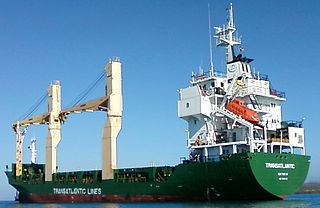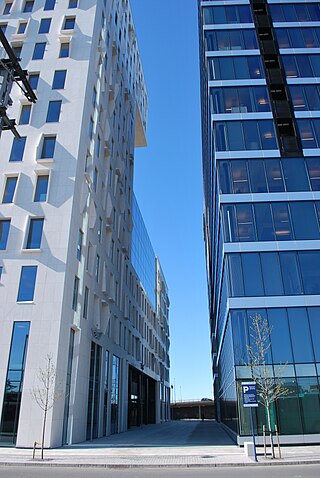KEMA NV, established in 1927, is a global energy consultancy company headquartered in Arnhem, Netherlands. It offers management consulting, technology consulting & services to the energy value chain that include business and technical consultancy, operational support, measurements & inspection, and testing & certification services.
A ship classification society or ship classification organisation is a non-governmental organization that establishes and maintains technical standards for the construction and operation of ships and offshore structures. Classification societies certify that the construction of a vessel complies with relevant standards and carry out regular surveys in service to ensure continuing compliance with the standards. Currently, more than 50 organizations describe their activities as including marine classification, twelve of which are members of the International Association of Classification Societies.
The International Association of Classification Societies (IACS) is a technically based non-governmental organization that currently consists of twelve member marine classification societies. More than 90% of the world's cargo-carrying ships’ tonnage is covered by the classification standards set by member societies of IACS.

The Germanischer Lloyd SE was a classification society based in the city of Hamburg, Germany. It ceased to exist as an independent entity in September 2013 as a result of its merger with Norway's DNV to become DNV GL.

Ice class refers to a notation assigned by a classification society or a national authority to denote the additional level of strengthening as well as other arrangements that enable a ship to navigate through sea ice. Some ice classes also have requirements for the ice-going performance of the vessel.

Polar Class (PC) refers to the ice class assigned to a ship by a classification society based on the Unified Requirements for Polar Class Ships developed by the International Association of Classification Societies (IACS). Seven Polar Classes are defined in the rules, ranging from PC 1 for year-round operation in all polar waters to PC 7 for summer and autumn operation in thin first-year ice.

MV Maria Reina is a Panamanian container ship. The 100-metre (330 ft) long ship was built at Wuhu Shipyard in Wuhu, China in 1997 as Steamers Future. Originally owned by Singapore's Keppel Corporation, she has had three owners, been registered under three flags, and been renamed ten times.
Henrik Overgaard Madsen is a businessperson, engineer, Member of the Board of Aker Solutions and was chief executive officer of DNV GL between 2006 and 2015.

Integrated Operations in the High North is a unique collaboration project that during a four-year period starting May 2008 is working on designing, implementing and testing a Digital Platform for what in the upstream oil and gas industry is called the next or second generation of Integrated Operations. The work on the Digital platform is focussed on capture, transfer and integration of real-time data from the remote production installations to the decision makers. A risk evaluation across the whole chain is also included. The platform is based on open standards and enables a higher degree of interoperability. Requirements for the digital platform come from use cases defined within the Drilling and Completion, Reservoir and Production and Operations and Maintenance domains. The platform will subsequently be demonstrated through pilots within these three domains.
Mayfair Vermögensverwaltung SE is the family office of the families of Günter Herz and Daniela Herz. It invests in long term holdings of companies, short term assets like stocks and bonds, and real estate.

The economy of the Greater Oslo area in Norway's southeast region plays an important role in the country's overall national economy. The Norwegian capital was named the 'priciest city in the world' in 2006 by the Economist Intelligence Unit, which compared the cost of living in 130 cities in a survey and ranked its findings.
GL Noble Denton is one of the oil and gas businesses of DNV GL, headquartered in Hamburg, Germany and London, UK. The company is an independent technical advisor to industry operators across the world.
Ship management is the activity of managing marine vessels. The vessels under management could be owned by a sister concern of the ship management company or by independent vessel owners. A vessel owning company that generally has several vessels in its fleet, entrusts the fleet management to a single or multiple ship management companies. Ship management is often entrusted to third parties due to the various hassles that are involved in managing a ship. For instance, ships could be considered as large factories that travel across seas under various weather conditions for several days at a stretch. These vessels are equipped with several types of machinery that require appropriate maintenance and the associated spares on board. In the scenario of a vessel lacking adequate maintenance, this could lead to the breakdown of the equipment in the middle of a voyage at sea. A breakdown could be an expensive affair. A second scenario would be – a vessel is continuously on the move or under some sort of activity and hence requires a competent crew. The documents of the crew need to comply with international regulations, their transportation to and from the vessel must be arranged for, their competencies must align with the requirement of the vessel and must complement the skillsets of the existing onboard crew. Hence several parameters must be considered which is a tedious job.

Valemax ships are a fleet of very large ore carriers (VLOC) owned or chartered by the Brazilian mining company Vale S.A. to carry iron ore from Brazil to European and Asian ports. With a capacity ranging from 380,000 to 400,000 tons deadweight, the vessels meet the Chinamax standard of ship measurements for limits on draft and beam. Valemax ships are the largest bulk carriers ever constructed, when measuring deadweight tonnage or length overall, and are amongst the longest ships of any type currently in service.
The Centre for Ships and Ocean Structures (CeSOS) is a research centre located at the Marine Technology Centre in Trondheim, Norway. The research centre's goal is to create fundamental knowledge about the design and operation of ships and ocean structures. The centre has been active since 2002, when it was established as a Centre of Excellence (CoE) by the Research Council of Norway and the Norwegian University of Science and Technology (NTNU). Although the financing period by the Research Council of Norway finished in 2012, research activities are still ongoing in 2013 and 2014, financed by external means.
Integrated Software Dependent Systems (ISDS) is an offshore oil IT system standard (DNV-OS-D203) and recommended practice guideline (DNV-RP-D201) covering systems and software verifications and classification of any integrated system that utilizes extensive software control. The ISDS Recommended Practice (DNV-RP-D201) was launched in 2008 by Det Norske Veritas (DNV), the Norwegian classification society. DNV Offshore Standard OS-D203 launched in April 2010.
Sesam is a software suite for structural and hydrodynamic analysis of ships and offshore structures. It is based on the displacement formulation of the Finite Element Method.

The Offshore and Onshore Reliability Data (OREDA) project was established in 1981 in cooperation with the Norwegian Petroleum Directorate. It is "one of the main reliability data sources for the oil and gas industry" and considered "a unique data source on failure rates, failure mode distribution and repair times for equipment used in the offshore industr[y]. OREDA's original objective was the collection of petroleum industry safety equipment reliability data. The current organization, as a cooperating group of several petroleum and natural gas companies, was established in 1983, and at the same time the scope of OREDA was extended to cover reliability data from a wide range of equipment used in oil and gas exploration and production (E&P). OREDA primarily covers offshore, subsea and topside equipment, but does also include some onshore E&P, and some downstream equipment as well.

RS Mistral is a container ship owned by Romy Shipping and operated by AS Myklebusthaug Management AS. The 127-metre (417 ft) long ship was built at Schiffswerft und Maschinenfabrik Cassens GmbH in Emden, Germany in 1999 as Westersingel. Originally owned by CV Scheepvaartonderneming Westersingel, she has had three owners, been registered under three flags, and been renamed eight times.










